17.08.2022
NASA’s Europa Clipper Spacecraft Kicks Assembly Into High Gear
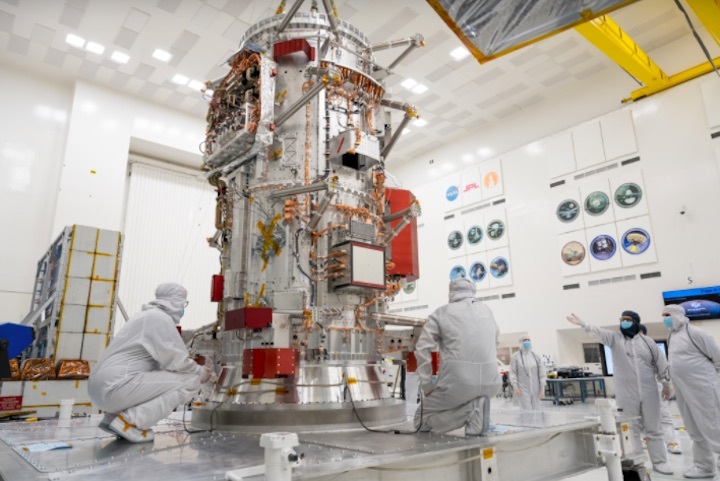
The spacecraft will occupy the main production facility of NASA’s Jet Propulsion Laboratory as it prepares for its 2024 launch to Jupiter’s moon Europa.
The core of NASA’s Europa Clipper spacecraft has taken center stage in the Spacecraft Assembly Facility at the agency’s Jet Propulsion Laboratory in Southern California. Standing 10 feet (3 meters) high and 5 feet (1.5 meters) wide, the craft’s main body will for the next two years be the focus of attention in the facility’s ultra-hygienic High Bay 1 as engineers and technicians assemble the spacecraft for its launch to Jupiter’s moon Europain October 2024.
Scientists believe the ice-enveloped moon harbors a vast internal ocean that may have conditions suitable for supporting life. During nearly 50 flybys of Europa, the spacecraft’s suite of science instruments will gather data on the moon’s atmosphere, surface, and interior – information that scientists will use to gauge the depth and salinity of the ocean, the thickness of the ice crust, and potential plumes that may be venting subsurface water into space.
This time-lapse video follows NASA’s Europa Clipper spacecraft during its carefully choreographed move into the High Bay 1 clean room the Spacecraft Assembly Facility at JPL.
Several of Europa Clipper’s science instruments already have been completed and will be installed on the spacecraft at JPL. Most recently, the plasma-detection instrument, called the Plasma Instrument for Magnetic Sounding, and the Europa Imaging System wide-angle camera arrived from the Johns Hopkins Applied Physics Laboratory (APL), in Laurel, Maryland. The thermal-emission imaging instrument, called E-THEMIS, and the ultraviolet spectrograph, Europa-UVS, have already been installed on the spacecraft’s nadir deck, which will support many of the instrument sensors by stabilizing them to ensure they are oriented correctly.
Fabricated at JPL, this key piece of hardware will soon move into the Spacecraft Assembly Facility’s High Bay 1, the same clean room where historic missions such as Galileo, Cassini, and all of NASA’s Mars rovers were built.
Also moving soon to High Bay 1 will be the aluminum electronics vault, which will be bolted to the main body of the spacecraft, protecting the electronics inside from Jupiter’s intense radiation. The electronics enable Europa Clipper’s computer to communicate with the spacecraft’s antennae, science instruments, and the subsystems that will keep them alive.
Bright copper cabling snaking around the orbiter’s aluminum core contains thousands of wires and connectors handcrafted at APL. If placed end to end, the cabling would stretch almost 2,100 feet (640 meters) – enough to wrap around a U.S. football field twice.
Inside the core are Europa Clipper’s two propulsion tanks. The fuel and oxidizer they’ll hold will flow to an array of 24 engines, where they will create a controlled chemical reaction to produce thrust in deep space.
By the end of 2022, most of the flight hardware and the remainder of the science instruments are expected to be complete. Then, the next steps will be a wide variety of tests as the spacecraft moves toward its 2024 launch period. After traveling for nearly six years and over 1.8 billion miles (2.9 billion kilometers), it will achieve orbit around Jupiter in 2030.
More About the Mission
Missions such as Europa Clipper contribute to the field of astrobiology, the interdisciplinary research field that studies the conditions of distant worlds that could harbor life as we know it. While Europa Clipper is not a life-detection mission, it will conduct a detailed exploration of Europa and investigate whether the icy moon, with its subsurface ocean, has the capability to support life. Understanding Europa’s habitability will help scientists better understand how life developed on Earth and the potential for finding life beyond our planet.
Managed by Caltech in Pasadena, California, JPL leads the development of the Europa Clipper mission in partnership with APL for NASA’s Science Mission Directorate in Washington. APL designed the main spacecraft body in collaboration with JPL and NASA’s Goddard Space Flight Center in Greenbelt, Maryland. The Planetary Missions Program Office at NASA’s Marshall Space Flight Center in Huntsville, Alabama, executes program management of the Europa Clipper mission.
Quelle: NASA
----
Update: 25.11.2022
.
NASA’s Europa Clipper Gets Its Wheels for Traveling in Deep Space
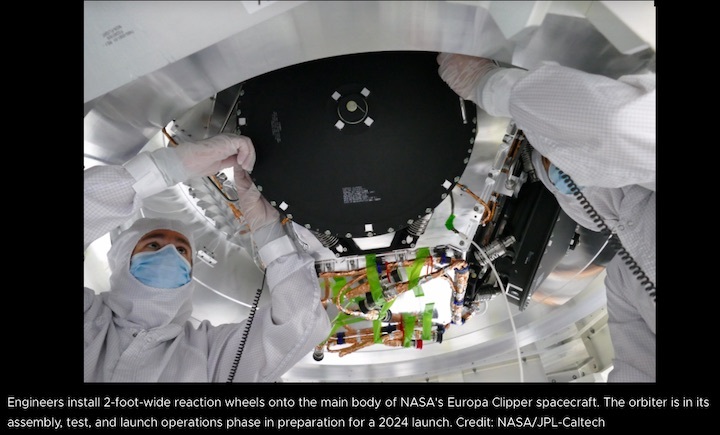
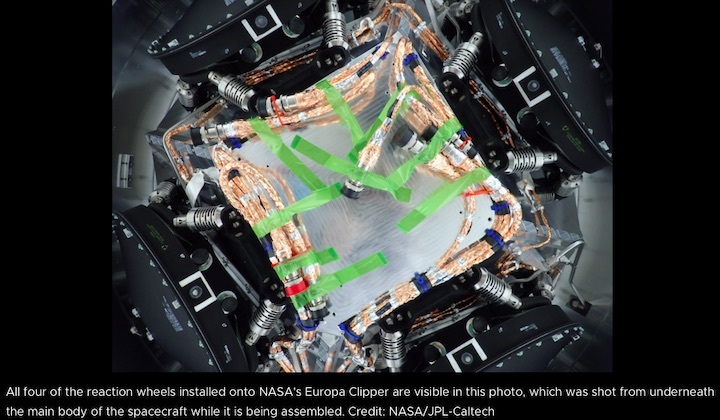
The enormous spacecraft that will head to Jupiter’s moon Europa uses four large reaction wheels to help keep it oriented.
Just as NASA’s Mars rovers rely on robust wheels to roam the Red Planet and conduct science, some orbiters rely on wheels, too – in this case, reaction wheels – to stay pointed in the right direction. Engineers and technicians at NASA’s Jet Propulsion Laboratory in Southern California recently installed four reaction wheels on Europa Clipper, which will rely on them during its journey at Jupiter’s icy moon Europa.
When NASA’s spacecraft heads through deep space, slips into orbit around Jupiter, and collects science observations while flying dozens of times by Europa, the wheels rotate the orbiter so that its antennas can communicate with Earth and its science instruments, including cameras, can stay oriented.
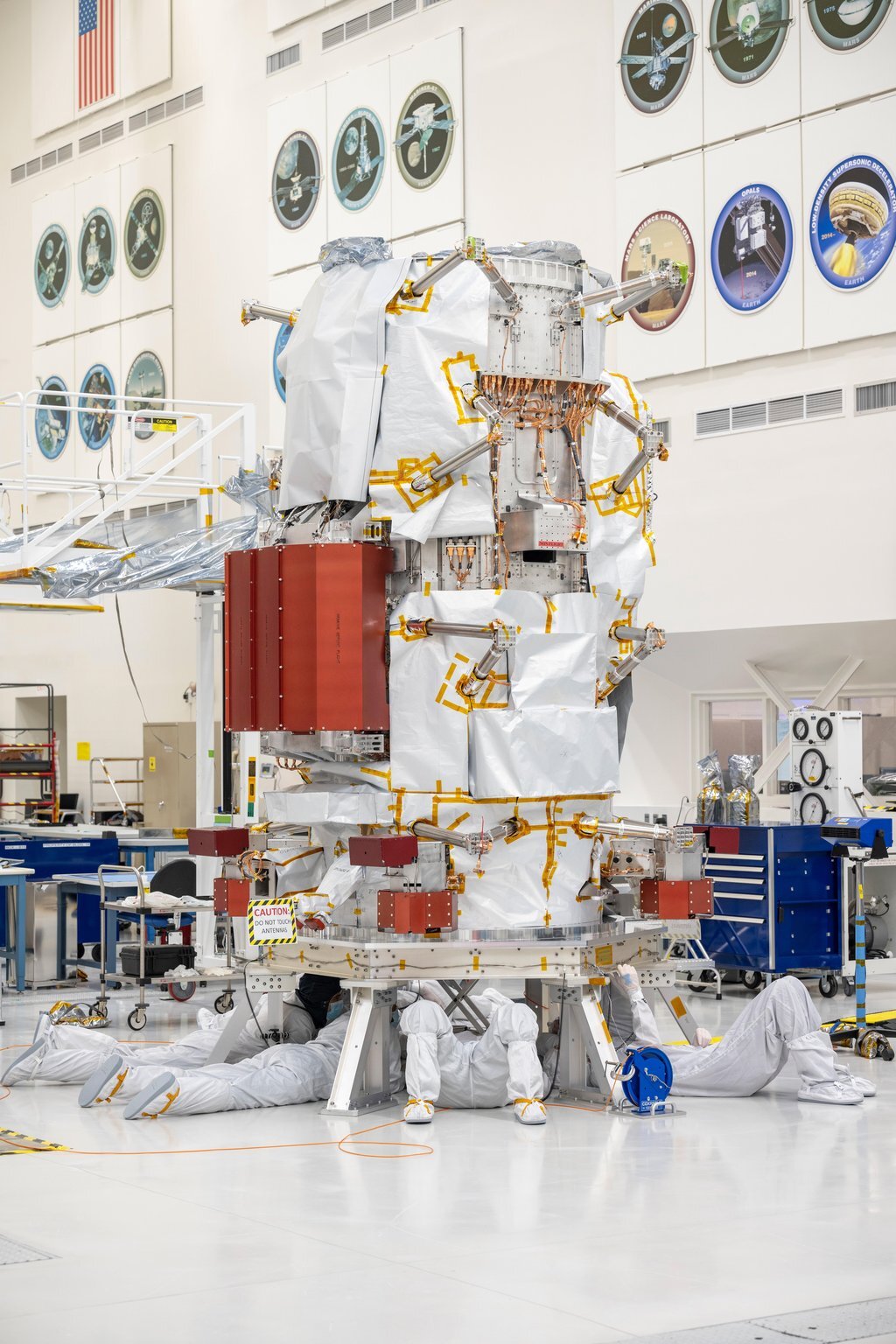
Credit: NASA/JPL-Caltech
Two feet wide and made of steel, aluminum, and titanium, the wheels spin rapidly to create torque that causes the orbiter to rotate in the opposite direction. Isaac Newton’s third law of motion also applies in deep space and explains the underlying phenomenon: For every action, there is an equal and opposite reaction. The reaction wheels cause the spacecraft to react to the spinning action of the wheels.
Here’s one way to visualize how reaction wheels work: Imagine you are sitting in a swivel chair and lift your feet off the floor so that you are free to rotate. If you jerk your torso one direction, the chair and your legs will rotate the opposite direction. The reaction wheels work the same way: As the reaction wheel’s motor accelerates the metal wheel in one direction, the spacecraft experiences an acceleration in the opposite direction.
Without those reaction wheels, Europa Clipper wouldn’t be able to do its science investigations when it arrives at the Jupiter system in 2030 after its 2024 launch. Scientists believe Europa harbors a vast internal ocean that may have conditions suitable for supporting life. The spacecraft will gather data on the moon’s atmosphere, surface, and interior – information that will help scientists learn more about the ocean, the ice crust, and potential plumes that may be venting subsurface water into space.
During its orbits around Jupiter, Europa Clipper will rely on reaction wheels to help it perform thousands of turns, or “slews.” Although the spacecraft could perform some of those maneuvers with thrusters, its thrusters need fuel – a finite resource aboard the orbiter. The reaction wheels will run on electricity provided by the spacecraft’s vast solar arrays.
The trade-off is that the reaction wheels work slowly. Europa Clipper’s reaction wheels will take about 90 minutes to rotate the craft 180 degrees – a movement so gradual that, from a distance, it would be imperceptible to the human eye. The rotation of the spacecraft will be three times slower than the minute hand on a clock.
Also, they can wear out over time. It happened on NASA’s Dawn spacecraft, requiring engineers to figure out how to rotate using thrusters with the available fuel. To address this, engineers have installed four wheels on Europa Clipper even though only three are needed to maneuver. They alternate which three wheels are in operation to even the wear. That leaves them with a “spare” wheel if one of the others fails
Installing the wheels was one of the most recent steps of the phase known as assembly, test, and launch operations. Science instruments continue to arrive at JPL to be added to the spacecraft. Next, a variety of tests will be conducted, as the spacecraft moves toward its October 2024 launch period. After traveling over 1.8 billion miles (2.9 billion kilometers), Europa Clipper will be set to begin unlocking the secrets of this icy world.
More About the Mission
Missions such as Europa Clipper contribute to the field of astrobiology, the interdisciplinary research field that studies the conditions of distant worlds that could harbor life as we know it. While Europa Clipper is not a life-detection mission, it will conduct a detailed exploration of Europa and investigate whether the icy moon, with its subsurface ocean, has the capability to support life. Understanding Europa’s habitability will help scientists better understand how life developed on Earth and the potential for finding life beyond our planet.
Managed by Caltech in Pasadena, California, JPL leads the development of the Europa Clipper mission in partnership with the Johns Hopkins Applied Physics Laboratory (APL), in Laurel, Maryland, for NASA’s Science Mission Directorate in Washington. APL designed the main spacecraft body in collaboration with JPL and NASA’s Goddard Space Flight Center in Greenbelt, Maryland. The Planetary Missions Program Office at NASA’s Marshall Space Flight Center in Huntsville, Alabama, executes program management of the Europa Clipper mission.
Quelle: NASA
----
Update: 4.05.2023
.
New Video Series Captures Team Working on NASA’s Europa Clipper
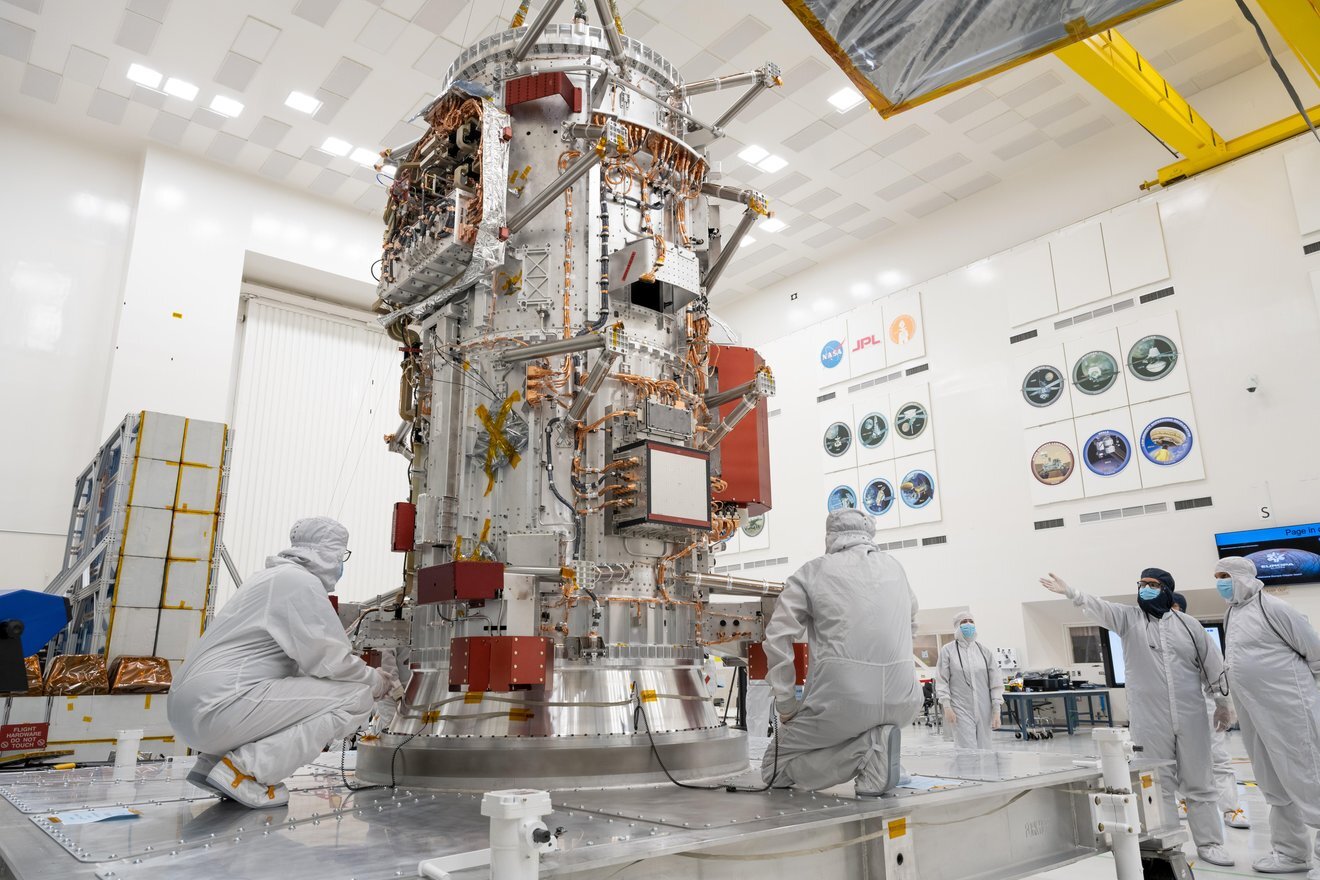
Engineers and technicians work on the towering main body of NASA’s Europa Clipper spacecraft at the agency’s Jet Propulsion Laboratory. A new video series lifts the curtain on the clean room and shows audiences what goes into building space missions.
Credit: NASA/JPL-Caltech
Led by NASA’s Jet Propulsion Laboratory, the short videos take audiences behind the scenes to learn more about how space missions come together.
Destined for Jupiter’s icy moon Europa, the Europa Clipper spacecraft – the largest NASA has ever flown on an interplanetary mission – is being readied to launch in October 2024. Between now and then, thousands of hours of work will go into assembling and testing the spacecraft to ensure it’s hardy enough to survive a six-year 1.6-billion-mile (2.6 billion kilometer) journey and sophisticated enough to perform a detailed science investigation of this mysterious moon.
The new video series “Spacecraft Makers: Europa Clipper” offers quick updates on the mission’s progress and lifts the curtain on the exacting work that goes into making sure the spacecraft reaches the Jupiter system in 2030. Europa Clipper aims to help answer questions about the ocean that scientists strongly believe lies below Europa’s icy crust.
Join NASA’s Europa Clipper mission team behind the scenes at the agency’s Jet Propulsion Laboratory to learn about the design of the spacecraft that will visit Europa, an icy moon of Jupiter. Learn how scientists’ questions translate into hardware, and get an update on how the build is going.
The spacecraft will fly by the moon about 50 times while orbiting Jupiter. (It can’t orbit Europa because doing so would bring Europa Clipper too close to the gas giant’s brutal radiation belts. Learn more in the video.) On each flyby, a suite of science instruments will gather data on the depth of the subsurface ocean, the thickness of the ice crust, and, potentially, the characteristics of any plumes that may be venting subsurface water into space. The goal is to find out whether Europa has the potential to support life.
The series’ premiere episode features Europa Clipper Project Manager Jordan Evans, who also has worked on NASA’s Curiosity Mars rover and the agency’s Hubble Space Telescope. In the video, he joins Deputy Science Manager Trina Ray, who worked on NASA’s Cassini and Galileo missions. They venture into JPL’s storied High Bay 1 clean room, where Europa Clipper is under construction – and where all of NASA’s Mars rovers, the twin Voyager spacecraft, and other historic spacecraft were assembled.
While you’re digging into the nuts and bolts of the spacecraft, check out a 24-hour live feed of assembly in progress in High Bay 1.
Additional episodes of “Spacecraft Makers” will include more activity inside other clean rooms where components of Europa Clipper are coming together. Future seasons of the series will cover other missions under construction at JPL.
More About the Mission
Europa Clipper’s main science goal is to determine whether there are places below the surface of Jupiter’s icy moon, Europa, that could support life. The mission’s three main science objectives are to understand the nature of the ice shell and the ocean beneath it, along with the moon’s composition and geology. The mission’s detailed exploration of Europa will help scientists better understand the astrobiological potential for habitable worlds beyond our planet.
Managed by Caltech in Pasadena, California, JPL leads the development of the Europa Clipper mission in partnership with the Johns Hopkins Applied Physics Laboratory (APL) in Laurel, Maryland, for NASA’s Science Mission Directorate in Washington. APL designed the main spacecraft body in collaboration with JPL and NASA’s Goddard Space Flight Center in Greenbelt, Maryland. The Planetary Missions Program Office at NASA’s Marshall Space Flight Center in Huntsville, Alabama, executes program management of the Europa Clipper mission.
Quelle: NASA
----
Update: 17.08.2023
.
NASA’s Europa Probe Gets a Hotline to Earth
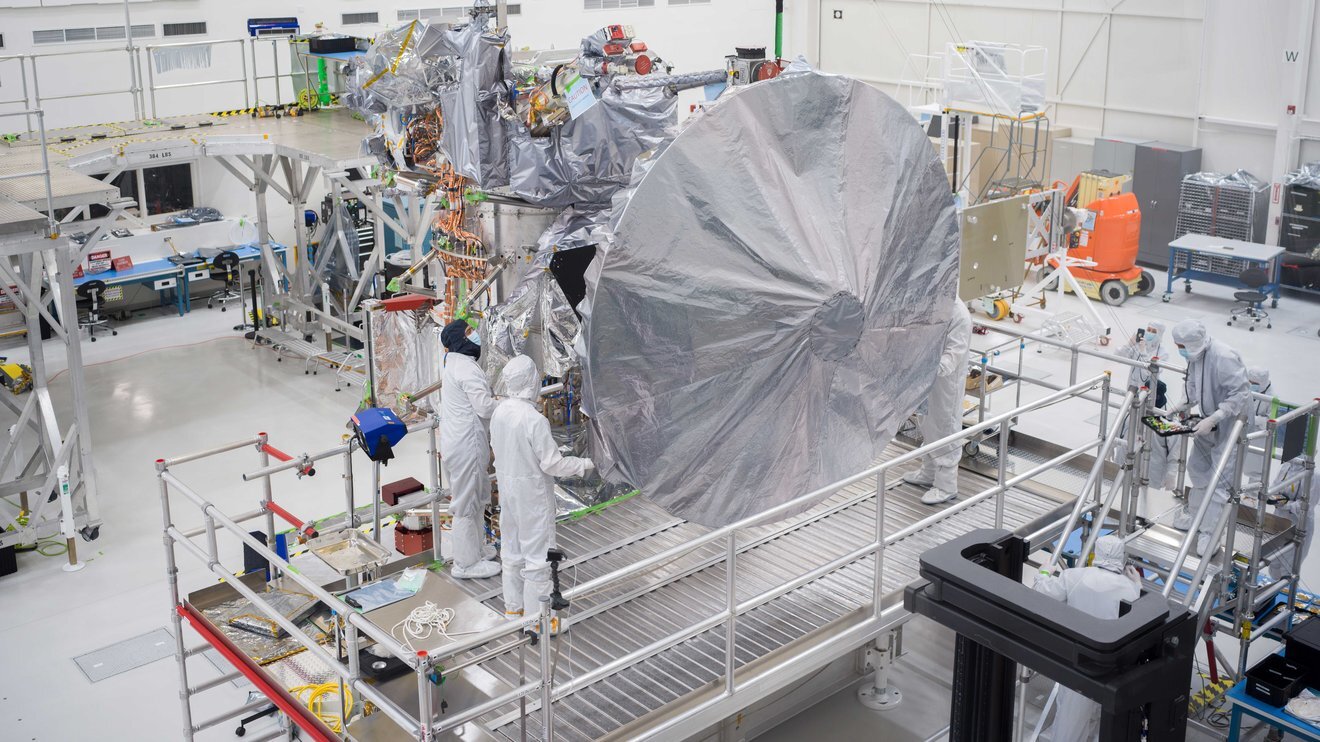
Engineers and technicians install Europa Clipper’s high-gain antenna in the main clean room at JPL.
Credit: NASA/JPL-Caltech
The addition of a high-gain antenna will enable the agency’s Europa Clipper spacecraft – set to launch in October 2024 – to communicate with mission controllers hundreds of millions of miles away.
NASA’s Europa Clipper is designed to seek out conditions suitable for life on an ice-covered moon of Jupiter. On Aug. 14, the spacecraft received a piece of hardware central to that quest: the massive dish-shaped high-gain antenna.
Stretching 10 feet (3 meters) across the spacecraft’s body, the high-gain antenna is the largest and most prominent of a suite of antennas on Europa Clipper. The spacecraft will need it as it investigates the ice-cloaked moon that it’s named after, Europa, some 444 million miles (715 million kilometers) from Earth. A major mission goal is to learn more about the moon’s subsurface ocean, which might harbor a habitable environment.
Watch as Europa Clipper team members lift and install the spacecraft’s large, dish-shaped high-gain antenna in the main clean room at NASA’s Jet Propulsion Laboratory.
Once the spacecraft reaches Jupiter, the antenna’s radio beam will be narrowly directed toward Earth. Creating that narrow, concentrated beam is what high-gain antennas are all about. The name refers to the antenna’s ability to focus power, allowing the spacecraft to transmit high-powered signals back to NASA’s Deep Space Network on Earth. That will mean a torrent of science data at a high rate of transmission.
The precision-engineered dish was attached to the spacecraft in carefully choreographed stages over the course of several hours in a Spacecraft Assembly Facility bay at NASA’s Jet Propulsion Laboratory in Southern California. “The antenna has successfully completed all of its stand-alone testing,” said Matthew Bray a few days before the antenna was installed. “As the spacecraft completes its final testing, radio signals will be looped back through the antenna via a special cap, verifying that the telecom signal paths are functional.”

Engineers and technicians use a crane to lift a 10-foot (3-meter) high-gain antenna as they prepare to install it on NASA’s Europa Clipper spacecraft. The orbiter is being assembled in the clean room of High Bay 1 at JPL in preparation for its October 2024.
Based at the Johns Hopkins University Applied Physics Laboratory in Laurel, Maryland, Bray is the designer and lead engineer for the high-gain antenna, which he began working on 2014. It’s been quite a journey for Bray, and for the antenna.
Just over the past year, he’s seen the antenna crisscross the country in the lead-up to the installation. Its ability to beam data precisely was tested twice in 2022 at NASA’s Langley Research Center in Hampton, Virginia. Between those two visits, the antenna made a stop at NASA’s Goddard Space Flight Center in Greenbelt, Maryland, for vibration and thermal vacuum testing to see if it could handle the shaking of launch and the extreme temperatures of outer space.
Then it was on to JPL in October 2022 for installation on the spacecraft in preparation for shipment next year to NASA’s Kennedy Space Center in Florida.
The long journey to Jupiter begins with launch from Kennedy in October 2024.
Europa in Their Sights
“The high-gain antenna is a critical piece in the buildup of Europa Clipper,” said Jordan Evans, the Clipper project manager at JPL. “It represents a very visible piece of hardware that provides the capability that the spacecraft needs to send the science data back from Europa. Not only does it look like a spacecraft now that it has the big antenna, but it’s ready for its upcoming critical tests as we progress towards launch.”
The spacecraft will train nine science instruments on Europa, all producing large amounts of rich data: high-resolution color and stereo images to study its geology and surface; thermal images in infrared light to find warmer areas where water could be near the surface; reflected infrared light to map ices, salts, and organics; and ultraviolet light readings to help determine the makeup of atmospheric gases and surface materials.
Clipper will bounce ice-penetrating radar off the subsurface ocean to determine its depth, as well as the thickness of the ice crust above it. A magnetometer will measure the moon’s magnetic field to confirm the deep ocean’s existence and the thickness of the ice.
Click on this interactive visualization of Jupiter’s moon Europa and take it for a spin. The “HD” button offers more detailed textures. The full interactive experience is at Eyes on the Solar System.
The high-gain antenna will stream most of that data back to Earth over the course of 33 to 52 minutes. The strength of the signal and the amount of data it can send at one time will be far greater than that of NASA’s Galileo probe, which ended its eight-year Jupiter mission in 2003.
On site at JPL for the antenna installation was Simmie Berman, the radio frequency module manager at APL. Like Bray, she began her work on the antenna in 2014. The radio frequency module includes the spacecraft’s entire telecommunications subsystem and a total of seven antennas, the high-gain among them. Her job during installation was to ensure the antenna was properly mounted to the spacecraft and that the components are correctly oriented and well integrated.
While the engineers at both APL and JPL have practiced the installation many times, virtually and with real-world mock-ups, Aug. 14 was the first time the high-gain antenna was attached to the spacecraft.
“I’ve never worked on anything of this magnitude, in terms of physical size and also in terms of just general interest,” she said. “Little kids know where Jupiter is. They know what Europa looks like. It’s supercool to get to work on something that has the potential for such a big impact, in terms of knowledge, for humanity.”
After completing this major milestone, Europa Clipper still has a few more steps and a few more tests ahead as it’s prepared for its trip to the outer solar system.
Quelle: NASAA year from launch, the Europa Clipper spacecraft nears finish line
The future of NASA's planetary science division is clouded by a budget crunch.
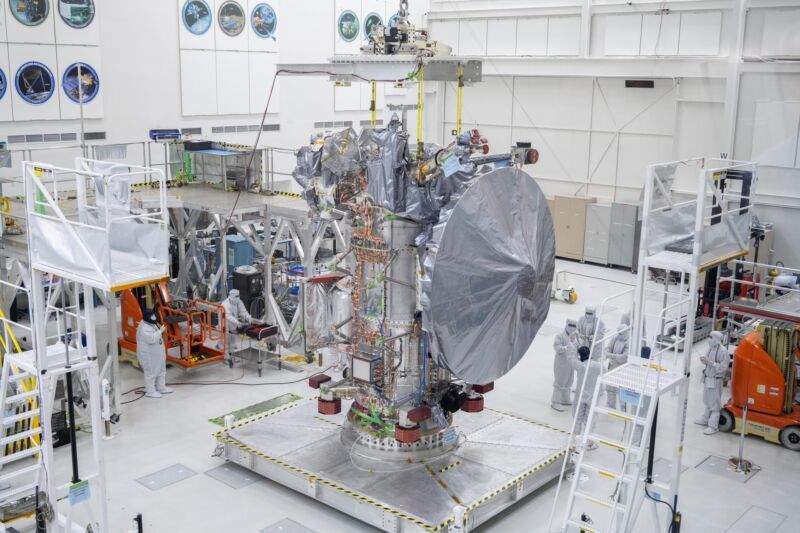
One of the final components added to the Europa Clipper spacecraft was the high-gain antenna, seen here during installation in August.
KENNEDY SPACE CENTER, Fla.—The launch window for one of the most expensive robotic space missions in NASA's history opens one year from Tuesday. Coming in at $5 billion, Europa Clipper will try to help scientists answer a bold question commensurate with its eye-popping cost: Are there places below the surface of Jupiter’s icy moon, Europa, that could support life?
Europa is slightly smaller than Earth's Moon and is significantly more interesting to scientists searching for life. The icy world harbors a vast global ocean of liquid water underneath a frozen crust. Clipper will sail past Europa nearly 50 times, coming as close as 16 miles (25 kilometers) from its icy surface to interrogate the moon with a sophisticated suite of nine instruments.
Jordan Evans, who leads the team developing Europa Clipper at NASA's Jet Propulsion Laboratory in California, told Ars on Tuesday the mission is on track to depart for Jupiter during a 21-day planetary launch window opening on October 10, 2024.
The engineers who map out intricate interplanetary trajectories have even determined exactly when Europa Clipper needs to launch. If it flies on the first day of the launch window, liftoff will occur at 11:51 am EDT, according to Evans. That could be slightly adjusted as navigators refine the mission's trajectory.
"It’s a 6,000-kilogram [13,000-pound] spacecraft with 100-foot [30-meter] wingspan solar arrays, with sensitive radar instruments on them, where all instruments have to operate simultaneously," Evans said. "So it’s a beast."
Evans spoke with Ars on Tuesday at the Kennedy Space Center, Europa Clipper's launch site, almost exactly one year, to the minute, before the mission's targeted liftoff time. Evans is at the site this week, familiarizing himself with SpaceX's operations as the company readies for the launch of a Falcon Heavy with NASA's Psyche asteroid mission.
"Clipper is doing great," Evans said, while acknowledging the mission has gone through its share of struggles.
Managers had to overcome staffing issues at JPL, which developed Europa Clipper in parallel with at least four other major missions. Then, a political battle was waged over which rocket would send Clipper into the Solar System. NASA officials finally ruled out launching Clipper on the Space Launch System after engineers discovered the spacecraft could be damaged by vibrations induced by the rocket's solid-fueled boosters.
In 2021, NASA selected SpaceX's Falcon Heavy for the job. The decision saved an estimated $2 billion, and some novel trajectory design allowed Europa Clipper to take a more direct route toward Jupiter than originally thought possible with a launch on a commercial rocket. That means Clipper will enter orbit around Jupiter in 2030.
The pandemic also threw a wrench into the mission. Delivery dates slipped for some of Clipper's science instruments as they encountered technical snags. But Evans said Tuesday that technicians assembling Clipper at JPL recently installed the final components needed for the spacecraft to start a final round of tests before shipment from the California lab to the launch site in Florida next May.
Those final additions included all but one of the mission's science instruments, a suite of cameras, spectrometers, and magnetometers to image Europa and measure the detailed composition of its icy shell. Clipper's electronics vault, an armored box to shield computers from the damaging radiation at Jupiter, was also recently installed on the main body of the spacecraft, along with a high-gain communications antenna to transmit data back to Earth.
“At launch minus one year, we have taken the flight vehicle through all of its paces," Evans said. "We’ve simulated launch, we’ve simulated trajectory correction maneuvers, Jupiter orbit insertion, and flybys of Europa with all the instruments operating on the flight hardware and software. The system performed great."
Testing on tap
Later this month, Clipper's ground team at JPL will move the spacecraft into a test chamber to blast it with sound, mimicking the acoustic environment it will have to withstand during launch. They will also put Clipper through vibration and shock testing to see how the craft responds to the shaking of a rocket flight.
Then comes an electromagnetic compatibility test, a milestone to ensure all of the electronics aboard Clipper can operate together as designed. Around the end of the year, engineers will transfer the spacecraft into a thermal vacuum chamber to subject it to the extreme hot and cold temperature swings it will see in space.
Some of the tests still to come for Clipper will be simulations to check the spacecraft's response to problems. Can the spacecraft detect, diagnose, and protect itself against the glitches that could crop up during its mission?
“From here on out, it’s all system-level testing to ensure that any flaws that got into that vehicle—because it is the work of human hands—that we can find them and correct them, if necessary, before we get to launch one year from today," Evans said.
After transporting the spacecraft across the country to Florida, Clipper's engineers will install the spacecraft's European-built solar arrays. Antennas for the mission's radar instrument will be mounted on the deployable solar panels. This radar package will measure the thickness of Europa's global ice sheet and study the internal structure of the icy crust, perhaps finding pockets of liquid water that connect the surface with the ocean below.
The radar is one of the instruments that sets Clipper apart from NASA's Galileo spacecraft, which gathered much of the information we know about Europa during its mission at Jupiter more than 20 years ago. Mission managers decided to install the solar panels and radar antennas at the launch site, rather than at JPL, as a hedge against delays in delivering those elements.
“There are always schedule risks," Evans said. "The team knows we’ve got a lot still ahead of us, but we definitely have ample schedule margin (for launch next October)."
Clipper, then what?
NASA's budget, like that of much of the federal government, is facing headwinds after the Biden administration and lawmakers agreed in June on spending caps on discretionary spending. Draft spending plans for fiscal year 2024 released by House and Senate committees earlier this year suggest Congress will primarily target NASA's science division for funding cuts while preserving money for the Artemis human exploration program to return astronauts to the Moon.
Planetary exploration has the largest budget among the disciplines in NASA's science division, about 50 percent more than Earth science and double the agency's astrophysics budget in fiscal year 2023. And planetary science missions aren't cheap. Even a mission like the Psyche asteroid explorer, which is part of NASA's cost-capped, lower-budget "Discovery" program, costs about $1.2 billion.
NASA's next big flagship-class planetary science priority after Europa Clipper is the Mars Sample Return mission, and it's in trouble, according to the results of an independent review released last month. NASA had been planning to launch the critical elements of its Mars Sample Return mission as soon as 2028, with a total budget for the program of $4.4 billion.
The review panel found that's just not realistic. The very earliest the mission could launch from Earth is 2030, and this opportunity would only be possible with a total budget of $8 billion to $11 billion.
NASA is taking the next few months to digest the review panel's recommendations. Going in, NASA's plan for Mars Sample Return was to retrieve tubes of rock specimens collected by the Perseverance rover, currently on Mars, and then launch them into space with a small rocket. A return spacecraft provided by the European Space Agency would pick up the samples and bring them back to Earth.
"They put some very actionable things in there, and some really great suggestions, looking at maybe other ways to implement the mission, and making sure that architecture is absolutely the right one to do," said Nicky Fox, the associate administrator for NASA's science division. "Are there ways that we can just change the mission design so that the annual cost comes down?
“We're very committed to bringing samples back from Mars," Fox said in an interview. "We're very, very committed to doing it. We're just going to take the next few months to make sure that we really are doing it in the best way."
With billions of dollars of expenditures for Mars Sample Return on the horizon and a tight budget environment across the federal government, NASA is taking a pause on approving new planetary science missions for development.
"It definitely has an impact to us," said Lori Glaze, director of NASA's planetary science division. "One of the few knobs that we have at NASA, that we can turn to adjust to those tightening budgets, is to delay some of those new opportunities. It's unfortunate. It’s not what we want to do. But we also don't want to start up new projects when we can't commit to the full funding that's going to be necessary."
Last month, NASA announced it would delay the next opportunity for a medium-class "New Frontiers" planetary science mission from this year until no earlier than 2026 because of budget issues.
The focus now for NASA's planetary science division is executing on the missions already in the pipeline.
“We have four missions in our portfolio that have already passed what we call their confirmation review, which is the point where NASA makes a commitment to the US government on cost and schedule," Glaze said.
Those four missions are Psyche, set for launch this week; Europa Clipper, launching next year; a lunar rover called VIPER, also set for launch next year, that will search for water near the Moon's south pole; and the Near Earth Object Surveyor, a telescope scheduled to launch no later than 2028 to find asteroids that might threaten Earth.
Quelle: arsTechnica

